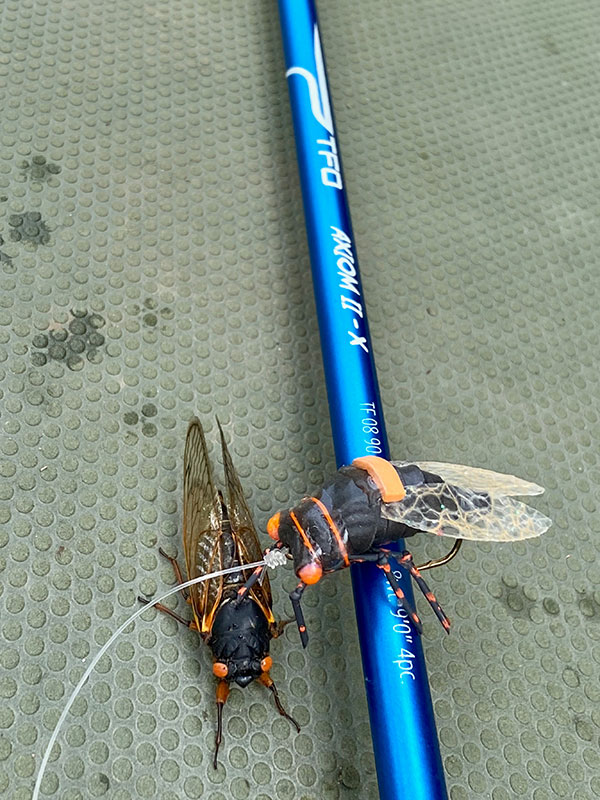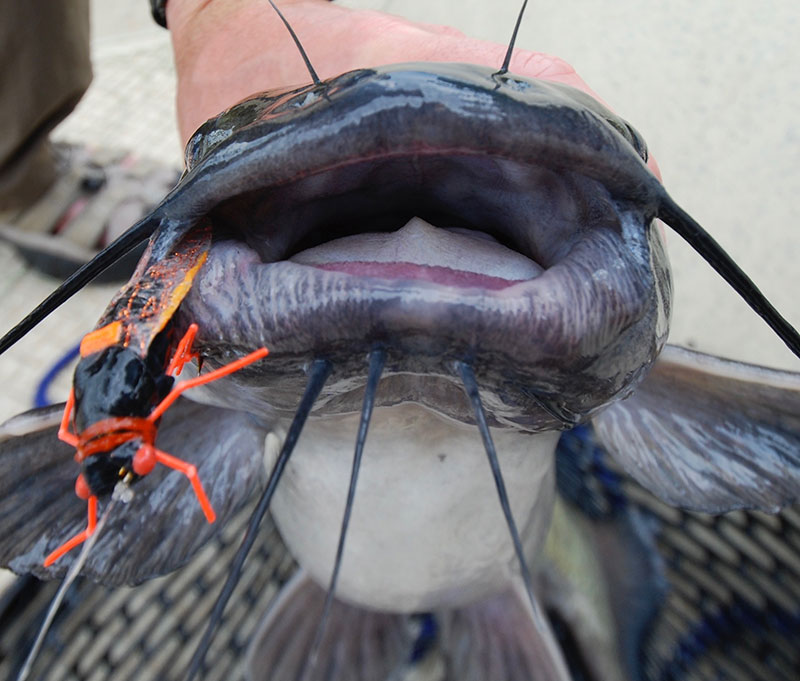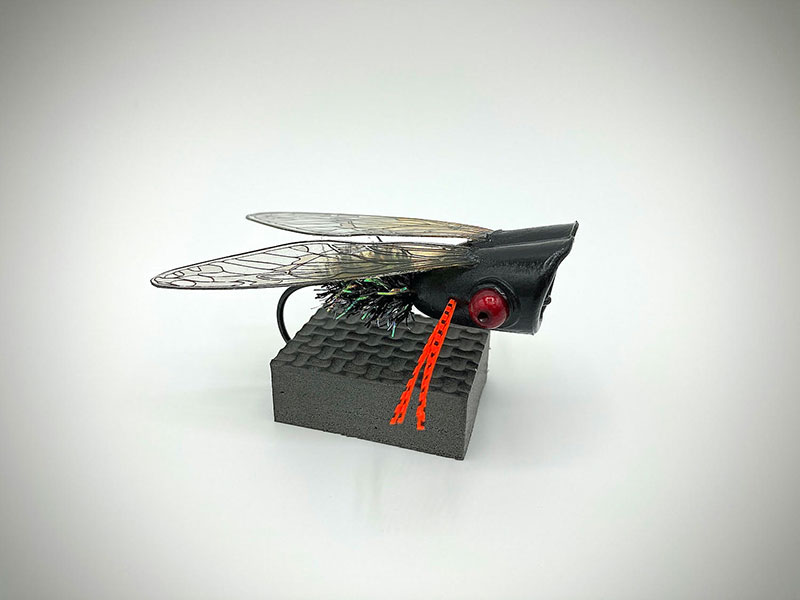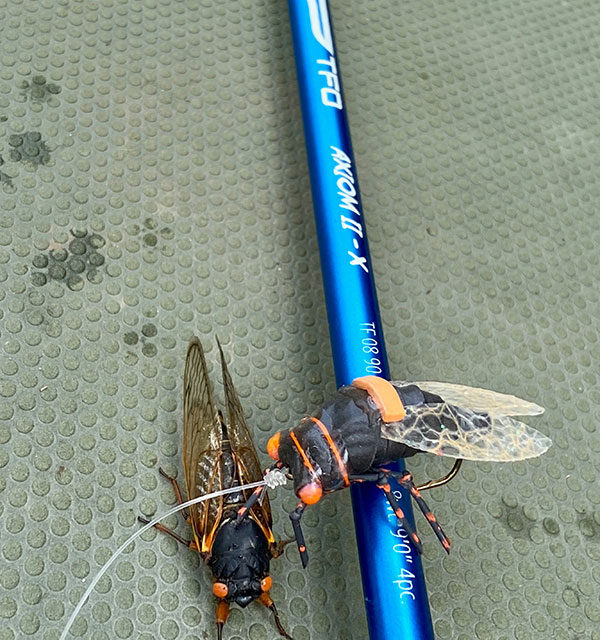Brood X- Are You Ready? April 30, 2021 – Posted in: Ambassadors, News
Entomologists and anglers across a big swath of the central-eastern U.S. are eagerly anticipating and unique event that will be starting soon. Last seen in 2004, this is the emergence of the “17 Year Locust”, which are actually a species of cicada. Brood X, is one of 15 periodical cicada broods that appear in the eastern U.S. These occur at both 13 and 17-year intervals. Specifically, this is the Great Eastern Brood and has the greatest range and highest concentration of the 17-year species.
Cicadas hatch annually across the U.S. and are recognized by their shrill mating call heard from trees on a hot, humid summer day. These large bugs (2.5” long) come in olive or olive and black coloring. Being clumsy fliers, they will fall into rivers and lakes where they are relished by a variety of gamefish. Even without seeing these insects on the water- cicada imitations still take fish. This is likely due to instinctive behavior that carries from early life stages when juvenile fish feed primarily on insects. A giant insect on the water can certainly entice a mature, predatory fish. Trout, bass, channel catfish, stripers, carp, and even muskies will all eat cicadas.
The emergence of the periodic broods takes this feeding to a whole different level. Scientific Anglers Ambassador, Blane Chocklett, says that this provides “some of the best fly fishing on planet earth”. To better understand how to take advantage of this opportunity, let’s take look at the emergence process of these insects in a bit more detail.
Brood X is expected to hatch in parts of 18 states. Most of this will happen in the month of May, but may occur in late April is some areas. A quick search online will give a number of sources that will be tracking the emergence. One of the most popular sites is www.cicadamania.com.
Once the ground reaches a sustained temperature of 64 degrees F at a depth of 8 inches, the Brood X nymphs will begin to emerge from the ground. They will climb the nearest vertical surface and shed their exoskeleton. The wings will inflate and the adult skin will harden. The periodic adults will have a black with orange coloration to them. In addition to being a different color, they will be a bit smaller than the annual cicadas. What makes this hatch so special is the sheer amount of biomass that will be present as millions of cicadas are emerging.
Locally, this becomes an important food source for both animals and fish. It usually takes about two weeks before fish key in on the bugs, so this gives you the opportunity to locate an area with an emergence and map out a strategy. There are different strategies on how to fish the emergence, so we will look at different schools of thought from two of our SA Ambassadors, Blane Chocklett and George Daniel. Both have extensive experience fishing cicadas
As far as basic gear goes, both favor at least a 7-wt. fast-action rod. Chocklett will bump up to an 8-wt. if larger fish like carp and stripers are expected. The leader needs to have a stiff, large diameter butt section to turn over the large, air-resistant flies used. Scientific Anglers Bass or Saltwater leaders tapered to 12 lb. to 16 lb. at the tippet will get the job done. This is matched to an aggressive-taper line like the new SA Bass Bug Taper or Titan Long. Bottom line- you need to be able to turn the fly over and making it hit the surface hard can help attract attentions and trigger strikes. This is also a situation where you want a reel with ample backing and a good drag as you may hook the fish of a lifetime.
Chocklett likes to fish lakes best for the periodic emergence. The increased amount of food dropping on the water will bring most all fish to the surface and there is minimal current to carry it away. Instead, wind can help to concentrate cicadas in a specific area and create a “buffet line” for feeding fish. He has seen schools of stripers up to 25 pounds cruise along sipping cicadas like brown trout. Gulpers on steroids is a good description.
For the most part, this is boat fishing and will be shoreline oriented as cicadas drop from the trees. You may have the opportunity to sight fish or you can slowly work your way along a tree-lined shoreline dropping your fly every 20 feet or so and letting it set for at least 10 seconds. The fly can be twitched a bit, but an active retrieve is not necessary. Often the fly hitting the water is all that is needed to trigger a take.
Chocklett says action during this cicada hatch can rival the famous western Salmon Fly hatches and the Palolo Worm of the Keys. He knows anglers that actually track the periodic cicada hatches and travel to fish them. Fishing Brood X may actually be your “dream trip” and this could be close to home.
George Daniel focuses on trout in moving water for the cicada hatch. He says, “It is not a finesse game and you need a line and leader that will turn over these larger patterns.” Again, the leader is an important part of the equipment. Scientific Angler’s 8’ Bass Leader is his choice. The large, air-resistant flies will twist traditional trout leaders.
On moving water, Daniel is not overly concerned with a long, natural float. He likes to twitch the fly to imitate the bug struggling on the surface. Use of a powerful leader, aggressive line taper, and forceful cast helps create the illusion of a fallen cicada.
One extra trick Daniel has in his bag is to use a sunken cicada pattern later in the hatch as the fish get more pressured and used to seeing floating patterns. Larger, wiser fish are less likely to rise and more likely to take the sunken fly. This is also a good way to fish broken, choppy water where cicadas naturally begin to sink. According to Daniel, “This was by far my best producing tactic for pressured, cicada-eating trout last time it hit my home waters in PA.”
There are numerous fly patterns for the hatch. Early in the hatch most anything close in size and color can work. Flymen Fishing Companies Double Barrel Poppers in black are a good choice. Michigan guide, Matt Zudweg, has a pattern based on these and also sells pre-made wings to make your own (www.boneyardflygear.com).
Farther along in the hatch, fish may get more selective and realistic patterns will produce better. A quick on-line search will show an extensive lineup of patterns from recognized names. Blane Chocklett, Dave Whitlock, Harrison Steeves, and Steve Yewchuck as well as a host of other tiers have realistic patterns. Most fly suppliers have cicada patterns or you will be able to find plenty of tutorials showing how to tie them yourself. Having several variations will help you have consistent success on picky fish.
We also need to add George Daniel’s Sunken Cicada in the mix as this is one you may not find readily available in most fly shops. This is a fairly simple pattern to tie and you should probably have a couple of them no matter where you are chasing Brood X.
Sunken Cicada
Hook: 2xl nymph or streamer, size 4
Thread: Uni, UTC, or Veevus fluorescent orange- 6/0, 70D
Back and top of head: Black Furry Foam
Body and bottom of head: Orange chenille
Legs: Orange Centipede Legs
Wings: Pearl Polar Flash or similar material with orange Krystal Flash mixed in
Wrap Up
Cicadas are always a target for fish when they are present. The periodic hatches take things to a whole new level and are eagerly anticipated by anglers “in the know”. The Brood X emergence will cover a large portion of the eastern U.S. and beyond. They are expected to make an appearance in the following states: Delaware, Georgia, Illinois, Indiana, Kentucky, Maryland, Michigan, North Carolina, New Jersey, New York, Ohio, Pennsylvania, Tennessee, Virginia, and West Virginia.
Some hatching activity may start in late April in the southern part of their range, but most is expected in May- happening later as you move north, with the peak expected the last two weeks of May. There will be a number of online sources to help keep track of the emergence. The website www.cicadamania.com gives complete info on the insects.
Where it occurs, the emergence will bring the largest fish in a given body of water- stream, river, and lake, to the surface in a feeding frenzy. Fly anglers should be prepared to take advantage of this opportunity. A little research and preparation could bring some of the best fly fishing that can be experienced anywhere. Will you be ready for Brood X?

The emergence of cicada Brood X will have millions of insects appearing across and large portions of the central and eastern United States. Photo by Blane Chocklett.

Once they hit the water, struggling cicadas will bring up a host of gamefish to the surface in a feeding frenzy. Photo by Blane Chocklett.

For cicada fishing success, be sure your outfit is matched to the size of the flies you are casting. 7-wt. to 8-wt. aggressive taper lines on fast rods are the norm with a heavy-butt, Bass or saltwater leader tapered to a minimum of 12 lb. tippet. Photo by Blane Chocklett.

Everything loves to eat cicadas! Even striped bass will stop chasing their usual baitfish to gorge on cicadas. Be prepared for the unexpected when fishing this hatch. Photo by Blane Chocklett.

Channel cats on topwater flies? You bet when the cicadas emerge! Brood X will provide a unique assortment of opportunities for fly fishers. Photo by Blane Chocklett.

Common carp and even grass carp, normally a vegetarian, will take advantage of the cicada hatch. Be sure your gear is up to the task for these hefty fighters! Photo by Blane Chocklett.

Find the imitation. Chocklett’s Cicada is a nearly perfect representation of the natural insects. Photo by Blane Chocklett.

Blane Chocklett releases a hefty cicada-eating bass. The emergence of these insects will bring normally top-water shy fish to feed on the surface even in bright sunshine.

Zuddy’s Cicada. Michigan guide, Matt Zudweg, offers this pattern using a popper body along with printed wings. Photo by Matt Zudweg.

The Sunken Cicada. Give this pattern a try in fast water and when the surface activity slows down. Photo by Jerry Darkes.

A group of periodic cicada patterns, ready to be fished. Photo by Jerry Darkes









4 Comments
Dave Stanley May 04, 2021 - 00:57
“Brood X” is one if the best and most unique flyfishing articles I have ever read. I grew up in Virginia and got to experience this first hand as a kid. I still remember how good the fishing was !!!! That was about 5 decades ago so I am planning on going back east ( I now live in Nevada) to give it another shot at the end of the month. Thanks again!!!!!!
S A May 12, 2021 - 19:12 – In reply to: Dave Stanley
Thanks Dave!
Geo. May 04, 2021 - 04:32
Looks like a Halloween costume to me. Trick or treat ?
S A May 12, 2021 - 19:12 – In reply to: Geo.
Not sure those treats would go over well with the neighborhood kiddos.